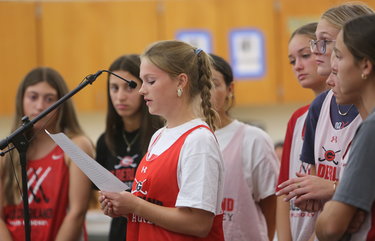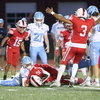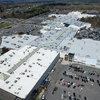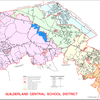Questions of equity arise as field hockey asks for an assistant coach
GUILDERLAND — For the second time in a month, the Guilderland School Board has heard requests from athletes, parents, and a coach about needed improvements to sports programs.
On Sept. 30, members of the varsity and junior-varsity field-hockey teams and their coach, Jennifer Sykes, who has led the program for nine seasons, asked for an assistant coach.
On Sept. 9, parents of girls on the tennis team had raised concerns about safety issues on the high school’s tennis courts because of cracked and uneven surfaces.
The varsity field hockey team has won back-to-back sectional titles, in 2023 and 2024.
Sykes noted that other field sports at Guilderland — girls’ and boys’ soccer, girls’ and boys’ lacrosse, and flag football — all have paid assistants.
“I’m getting older. The job’s not getting easier for me physically …,” Sykes said. “We’re not asking for more. We’re just asking for equity.”
She said she didn’t think the district’s Diversity, Equity and Inclusion Committee had ever “really taken a look at athletics.”
Avery Ralston, a ninth-grader and one of the captains of the junior-varsity field hockey team, said of the field-hockey coaches, “On and off the field, they teach the values of teamwork, self-discipline, and determination. They challenge us, believe in us, and are not only shaping us as field-hockey players but also as individuals.”
She went on, reading from a statement, “But they are spread thin and Coach Sykes needs help. She has 24 players on her team.”
Ralston also said that many student athletes dream of playing in college and some rely on athletic scholarships to get there.
Alice Cavillones, a senior on the varsity team, noted, “The girls’ flag football team is a very new team and they already have a paid assistant coach.”
Lydia Santabarbara, a junior who has played on the varsity team for three years, said of Sykes, “She puts in not to just varsity, but to our youth program and helping out with JV and modified … Everyone wants her time, but everyone cannot get her time.”
Marissa Bibbo, a junior of the team, said that, with 24 players “doing multiple drills for all of our different positions, it’s really hard for Coach Sykes just to be in five areas at one time.”
The school board also heard on Sept. 9 and again on Sept. 30 from parents requesting a ninth-grade girls’ volleyball team since there is such interest in the sport.
“I know the cost will be minimal to the overall budget, but you will significantly impact many students in the district because of the ripple effect of adding this team,” wrote parent Seema Rivera, who formerly served as the school board’s president but left the Guilderland board when she was appointed to the state’s Board of Regents.
Athletic overview
David Austin, who oversees athletics for the district, reported to the board on the tennis courts and also answered more far-reaching board questions.
Tara Molloy-Grocki said, “The boys got $119,484 more than the girls in the budget. The boys got $329,664 and the girls received $210,180.”
She asked, “Why is it so much for the boys’ sports?”
Austin said that eighth-graders advocating for female sports had just asked “that very question.”
One discrepancy, Austin said, is that, by law, football equipment has to be reconditioned every year for safety reasons.
“There’s no other sport that we offer that requires me to turn the equipment in at the end of every year to have reconditioned,” he said, and the cost of that keeps increasing.
Superintendent Daniel Mayberry said, “As we review the information asked about coaches, sports, assistant coaches, and things like that … we’ll be able to tease out what sports we have, what coaches we have, and then look at the cost that way, which would give him a more accurate answer as to why there is a discrepancy.”
Assistant Superintendent for Business Andrew Van Alsstyne said that an internal audit on Title IX and equity had been done at Guilderland in 2021-22 and found “nothing substantial about equitable differences between boys’ and girls’ funding or resources.”
Board member Meredith Brière asked if any school sports had declining participation.
Austin responded that the pandemic had affected some sports more than others and girls’ soccer had been reduced from four levels to three levels this year. “We aren’t alone there,” he said, stating, “Some other schools in our league are doing the same.”
Austin went on, about participation levels, “For the most part, we’re pretty good.” He said half of Guilderland students participate in at least one sport and a quarter participate in two.
“We’re a smaller school compared to some other schools in our league,” Austin said. Guilderland has about 1,500 high school students in a district with nearly 5,000 students overall.
“So,” Austin went on, “we need that multi-sport mentality and, for the most part, we have that, which is good.”
He cautioned, however, that enrollment is declining at the elementary level. “That’s something we’ve got to keep an eye on going forward,” said Austin. “That’s likely going to have an impact on our numbers … certainty in the next eight to 10 years.”
Van Alstyne had said earlier that the lack of affordable housing in Guilderland, essential for young families, may be part of the cause for enrollment decline in Guilderland, which is greater than the national decline or in other districts regionally.
Guilderland Town Board members, in reviewing development proposals, have recently voiced support for projects including affordable or workforce housing. And the Guilderland Industrial Development Agency has been working out a definition and criteria for workforce housing.
As she had on Sept. 9, board member Kim Blasiak suggested the board take an overall look at the district’s sports program rather than considering needs in a piecemeal fashion.
“I think just an overall would be good to know, especially before we start adding new teams to the mix, seeing what we currently have right now that really needs that support,” Blasiak said.
Later in the meeting, the board’s president, Blanca Gonzalez-Parker, repeated Blasiak’s point and said, “We would like to hear about assistant coaches across the board. How were the decisions made? Who has them? Who doesn’t? Is there, in fact, a disparity between male and female teams? That sort of thing.”
Tennis courts
Guilderland has eight tennis courts at the high school, configured in two sets of four each.
The east courts, closest to the football field, were resurfaced in 2017, Austin said.
“That included new fencing, posts, nets, and surface,” he said. “Those courts have held up reasonably well but are now starting to show the signs of aging,” he said, with cracks on some of the courts.
Copeland Coating Company will be working on the east courts this week and then will work on the west courts, he said.
“Courts have a lifespan of about 10 to 15 years,” he said, advising “full reconstruction on the east courts in the very near future.”
The west courts, closest to the district offices, were slated for full reconstruction as part of a 2019 capital project that was defeated, so the project was scaled back and “partial renovations” were done in 2021, Austin said.
Rather than roughly $600,000 for full reconstruction, “closer to $250,000” was spent, he said.
“Issues appeared very quickly,” Austin said, starting with minor cracks on the outside perimeter but now on the court of play.
Rain does not drain or dry properly, he said, making the courts slicker and creating pools of water.
Those problems, Austin said, “highlight the limitations of partial fixes versus full reconstruction.”
He concluded, “Both sets of courts, in my opinion, should be considered for full reconstruction in the next capital project put out to voters …. Current conditions impact playability, safety, and overall experience. And I’ll add, you know, tennis participation here is strong.”
Junior varsity and varsity girls compete in the fall with the boys competing in the spring. The courts also get “regular community use,” he said, and are used by youth camps in the summer.
Board member Rebecca Butterfield said she was frustrated to hear about the condition of the courts now rather than ahead of the capital project which was passed by voters in May.
“It just makes me wonder what other issues are we missing that weren’t included in the capital project that could have, you know, deleterious consequences to our students or staff,” she said.
Board member Nina Kaplan asked why Guilderland’s courts were deteriorating “faster than what would be anticipated generally.”
She asked, “Is there possibly another underlying cause?”
“Where our courts are is not the best,” said Austin.
“I think part of what you have to deal with is a high water table …,” said Superintendent Mayberry. “It’s not like you’re building them on a hill where it naturally drains … It’s that back-and-forth temperature swing that we have is what’s causing the majority of this rapid deterioration.”
Mayberry concluded by stressing, “Right now, let’s just be clear. The courts are not deemed unsafe. They’re not perfect. We have a repair cycle that’s sort of starting to address that … They will, in theory, with continued maintenance, last about five years, which would put it right in cycle with most likely the next capital project.”
Gonzalez-Parker then described “sink-hole type things that collect the water and they’re all black from mildew, but they are an uneven surface and people do literally roll their ankles in them.”
“It’s small indentations,” responded Maberry, calling “sinkholes … a little strong of a description.”
Mayberry said, “In general, most athletes that are playing on the court are not going to be injured by these because to some degree most courts are not perfectly flat all the way across.” He insisted, “They haven’t been deemed unsafe.”
“I encourage everyone in the community to go and settle this dispute and look and see if they think they look like sinkholes,” said Gonzalez-Parker.
“Either way,” responded Mayberry, “it’s probably not going to change our timeline. The only thing it’s probably going to do is people are going to make their own choice of whether they use it or not at this point.”



